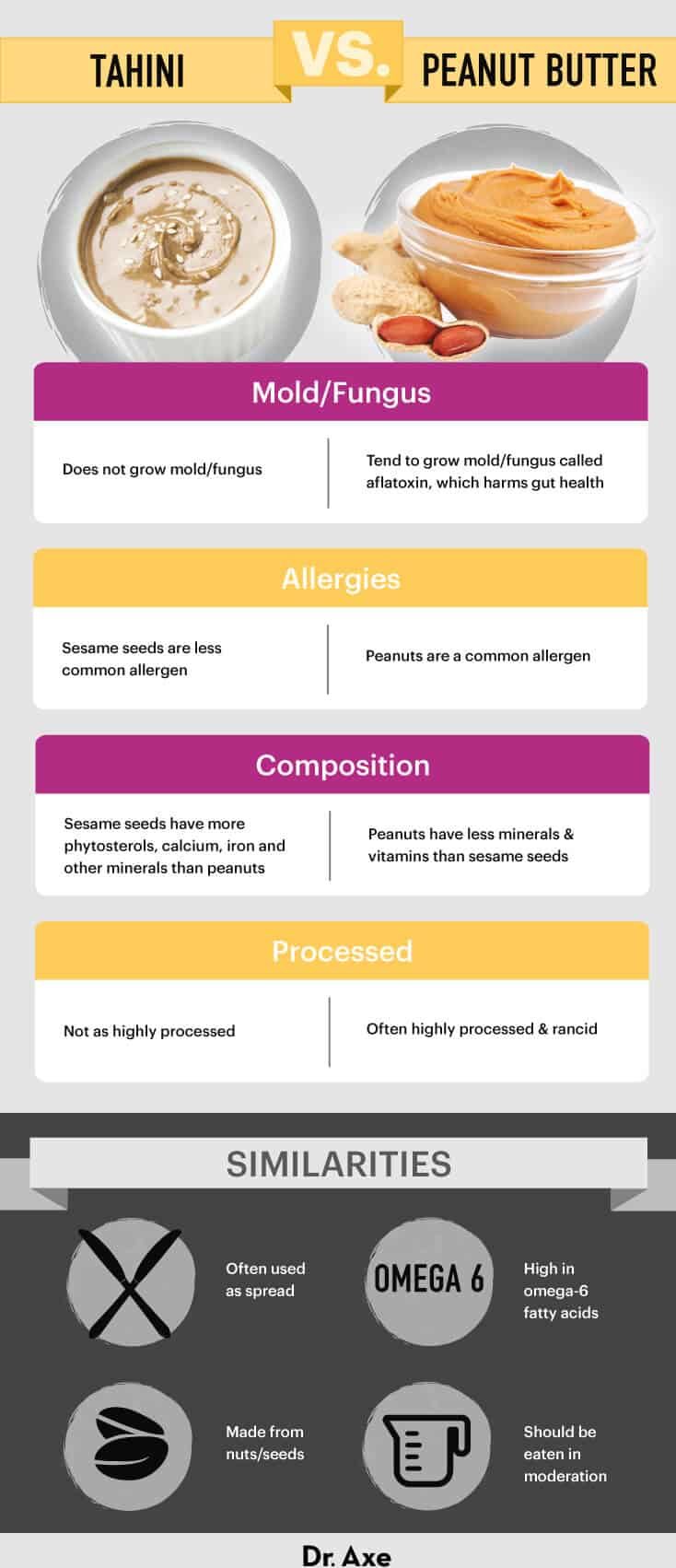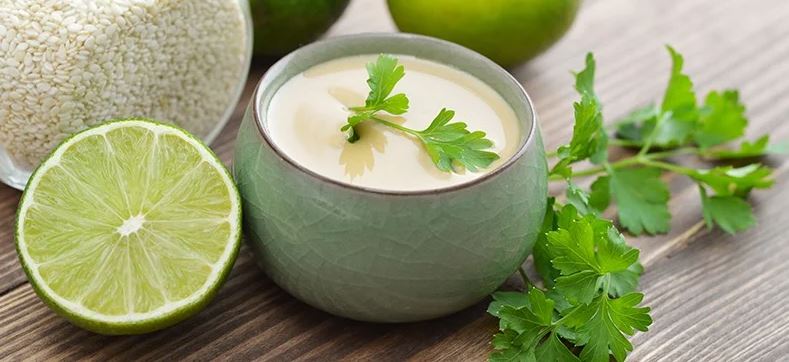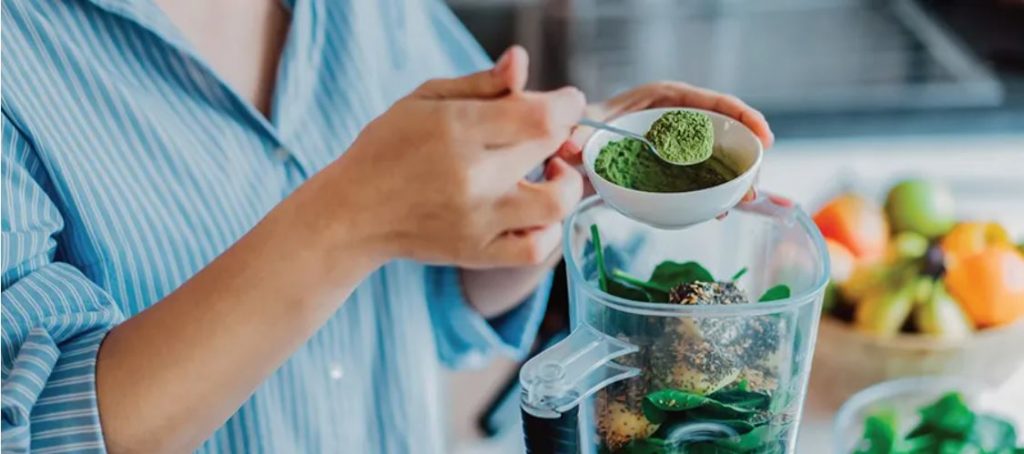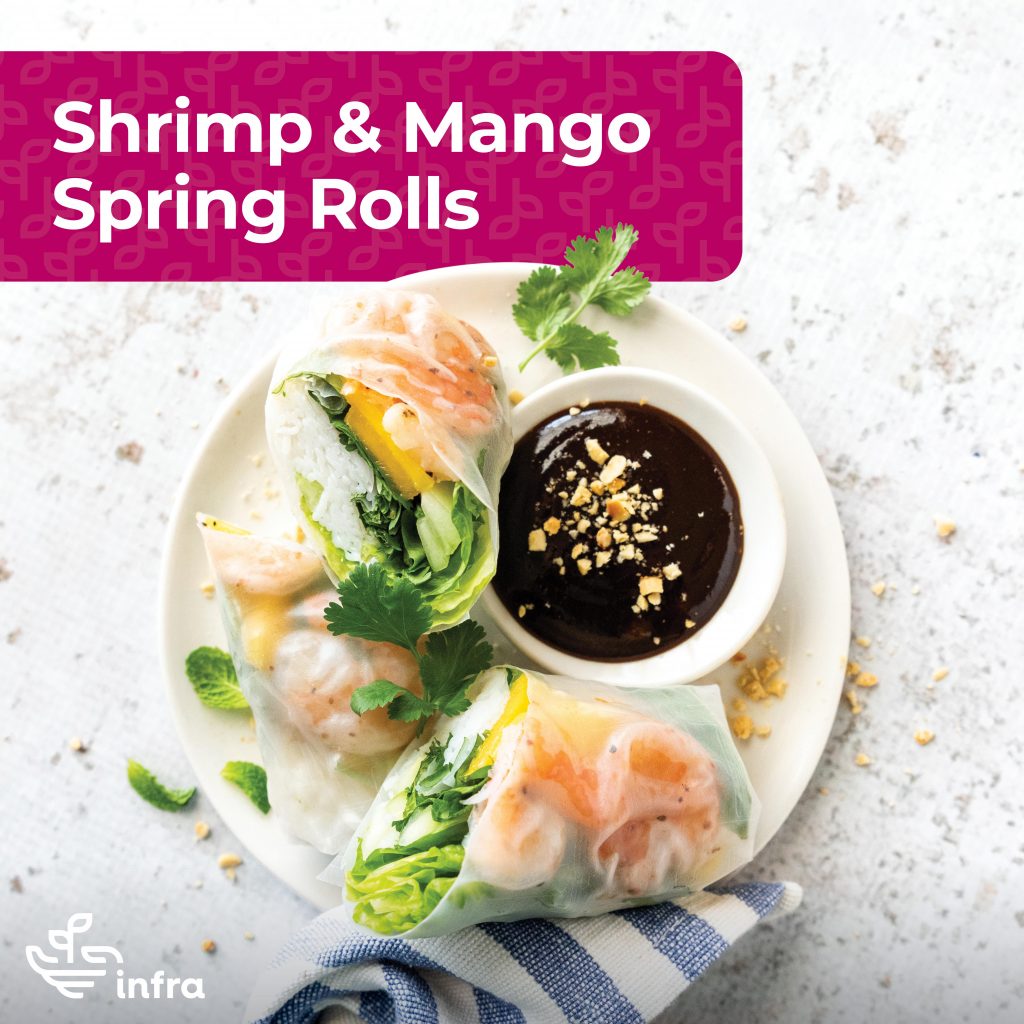Had Hummus Lately? Tahini Boosts Both Immunity & Heart Health
April 23, 2019

Have you ever checked out the ingredients of your favorite hummus and noticed tahini among those listed? That’s a good thing, because tahini sauce is made from ground sesame seeds, which we know are nutritious in their own right.
In fact, research shows that sesame seeds and, thus, tahini have similar immune-boosting, cardiovascular-protective abilities as superfoods like olive oil, walnuts and flaxseeds. But that’s not all.
What Is Tahini?
A staple of Middle Eastern and Mediterranean cuisine, tahini is a type of sauce or paste made from ground sesame seeds (Sesamum indicum). Sesame seed is the seed of the sesame plant, which is just one Sesamum species among the 40 that belong to the plant family called Pedaliaceae.
Tahini has been popular in North Africa, Greece, Israel, Turkey and Iraq for thousand of years, where it’s still used as a primary ingredient in hummus recipes, baba ghanoush, halva and as a dip all on its own.
Over 4,000 years ago, tahini sauce was written about in ancient texts that originated around the Tigris River and Euphrates River and by historians, including Herodotus, who recalled tales of it being served to royalty, as it was considered a food worthy of the gods.
Since about the 1940s, tahini has been available in the U.S. Until recently you were only likely to find it in health food stores or ethnic markets, but today it’s sold in most major supermarkets and included in recipes at popular restaurants.
What makes tahini beneficial? Just like other seeds and nuts, sesame seeds within the sauce help lower cholesterol, provide dietary fiber for digestion, improve blood pressure, balance hormones and more.
Health Benefits
1. High in Healthy Fats and Amino Acids
Is tahini a healthy fat, or is tahini fattening? Compared to other nuts and seeds, sesame seeds have one of the highest oil contents by weight — which is why tahini is exceptionally silky smooth compared to other nut butters (like peanut or almond butter). Sesame seeds contain up to 55 percent oil and 20 percent protein, the reason they’re well-known for providing both healthy fats and certain essential amino acids (the building blocks of protein).
While it might be a high-calorie food based on volume, a small amount of tahini goes a long way. It has a rich, nutty flavor that comes through strongly in recipes — plus it can benefit your heart, hormonal and skin health even when you use just a small amount. Most of sesame seeds’ fat is polyunsaturated fat, while a small amount is monounsaturated and saturated. Roughly 50 percent to 60 percent of the fat within tahini is made up of two beneficial compounds: sesamin and sesamolin.
Tahini also contains phenolic compounds, linoleic acid, oleic acid, gamma-tocopherol and amino acids, including lysine, tryptophan and methionine. Sesame seeds are around about 20 percent protein by weight, making them a higher protein food than most other seeds or nuts. Is tahini good for weight loss? Of course it depends on how much of it you eat, but generally speaking healthy fats like tahini are necessary for appetite control and feeling satisfied between meals.
2. Great Source of Essential Vitamins and Minerals
Tahini is a great way to obtain B vitamins like thiamine, along with minerals, including magnesium, copper, phosphorus, manganese, iron and zinc. Adding it to recipes is a good way to get your daily copper — which is needed to maintain nerve, bone and metabolic health — and prevent copper deficiency. The iron in tahini helps prevent anemia, which is a disorder characterized by low red blood cell counts, iron deficiency and fatigue. And B vitamins within tahini are important for metabolic functions, dealing with stress and many cognitive processes.
Another important attribute of sesame seeds their plant lignans content. Lignans have been shown to have anticancer effects and heart-promoting abilities. Studies have found that precursors from sesame seeds are converted by the bacterial flora in the colon to mammalian lignans equivalent to those obtained from flaxseeds, which have always been thought of as the best lignan source.
3. Helps Regulate Blood Pressure and Cholesterol
Why is tahini good for your heart? Sesamolin and sesamin prevalent in sesame seeds have been found to have antithrombotic properties. This means sesame might help prevent cardiovascular diseases tied to disruptive effects and legions within the arteries, such as acute coronary syndrome and cardiovascular death. In addition, phytosterols are a type of nutrient found in sesame seeds that have effects on hormonal levels, arterial health and cholesterol levels. The majority of the plant sterols in tahini are called beta-sitosterol. Sesame seeds rank highest in cholesterol-lowering phytosterols among 27 different nuts, seeds, legumes and grains tested (400 grams of phytosterols per every 200 grams of seeds).
Although sesame seeds are high in fat and calories, this isn’t a bad thing when it comes to heart health. Research suggests that phytosterols can be used to treat arteriosclerosis, a disease characterized by fatty buildup within the arteries. Phytosterols are able to help regulate cholesterol in the body because they have a similar structure to cholesterol. That means they can help replace some of it and block its absorption within the intestinal tract. This decreases the amount of absorbable cholesterol within the bloodstream and is beneficial for people suffering from certain heart complications.
Sesame seeds used to make tahini are also high in plant lignans, which may help improve blood lipid profiles and can normalize cholesterol and blood pressure. Research shows that lignans help lower cholesterol naturally, both serum blood cholesterol and liver cholesterol levels. This means they have positive effects on total cholesterol, lowering LDL cholesterol (the so called “bad kind”) and improving the LDL-to-HDL cholesterol ratio.
If you suffer from high blood pressure, tahini can help with that too. Sesame seeds have antihypertensive properties, according to studies investigating the effects of sesame taken by adults with high blood pressure. A 2006 study published in The Yale Journal of Biology And Medicine followed 32 hypertensive patients over the course of 45 days as they used sesame oil as their only form of dietary oil. Researchers found that over the 45 days sesame oil helped significantly lower blood pressure, decrease lipid peroxidation and increase antioxidant status in the majority of patients.
4. Can Help Balance Hormones (Especially in Menopausal Women)
Phytoestrogens are a controversial topic, especially when it comes to their effects on hormones. They both mimic estrogen and act as estrogen antagonists (meaning they behave in the opposite way of biological estrogen), which makes them a bit confusing to understand. They affect the body by attaching to estrogen receptors, which tricks your body into thinking you have more or less estrogen than you really do. It’s not so cut-and-dry as to say whether or not phytoestrogens are either good or bad, but studies show they do have their benefits.
Estrogen-building foods usually get a bad reputation — and for good reason, considering the standard American diet tends to be high in foods that promote estrogen dominance, which is problematic. But not all of phytoestrogens’ effects are bad. For certain people, especially in post-menopausal women over 50 or women who are otherwise low in estrogen, studies suggest that phytoestrogen foods can actually be beneficial. They naturally balance hormones, help maintain strong bones, and lower the risk for various diseases like cancer and osteoporosis.
Dietary estrogens seem to be most protective for women during menopause, a time in which a woman transitions from her last menstrual cycle, ends fertility and experiences adjustments in hormone levels, especially estrogen and progesterone. Purposefully increasing phytoestrogen intake isn’t a good idea for most people and might be harmful, but it can also help counteract the effects of hormonal imbalances that women begin to experience as they get older. Some studies have found that increased phytoestrogens help drastically reduce menopause symptoms, including hot flashes, bone loss, weakness, mood changes, low sex drive, etc.
5. Helps Improve Skin Health
Sesame seeds are a good source of amino acids, vitamin E, B vitamins, trace minerals and fatty acids that all help with skin cell rejuvenation and preventing early signs of aging. While you might not want to slather tahini directly on your skin, eating it can help improve the integrity of your skin by boosting your fat and nutrient intake.
Sesame oil has been used to treat skin wounds, burns, sensitivities and dryness for thousands of years, which is why it’s sometimes called “the queen of oils.” It’s a natural antibacterial and antifungal agent. That means it kills bacteria that can clog pores. Healthy fats in general are key for skin health because fats are needed to lower inflammation and keep skin moist. Tahini also provides minerals like zinc, which are needed to repair damaged tissue and produce collagen that gives skin its youthful elasticity and firmness.
6. Boosts Nutrient Absorption
Studies have found that sesame seeds help boost absorption of protective fat-soluble compounds like tocopherol, the major nutrients within vitamin E that play a role in the prevention of human aging-related diseases, such as cancer and heart disease.
When researchers tested the effects of sesame seed consumption in humans over a five-day period, they found that sesame (but not walnuts or soy oil) significantly elevated serum gamma-tocopherol levels by an average of 19.1 percent in subjects. The fact that sesame leads to elevated plasma gamma-tocopherol and enhanced vitamin E bioactivity means it might be effective for preventing inflammation, oxidative stress and therefore chronic disease development.

Nutrition Facts
Tahini is made from soaking sesame seeds and then toasting and crushing them into either a thicker paste or a smoother sauce. The sesame seeds that are used in most tahinis are first “hulled.” This means they’re soaked to help separate the bran from the kernels, which results in a smoother finished product. Unfortunately, at the same time hulling removes many of the benefits of tahini since it discards the bran of the sesame seeds, where many of the nutrients are stored. It’s always best to buy unhulled tahini if you can find it (or to make your own) in order to keep the whole seed intact.
The goodness of tahini comes down to the many health benefits of sesame seeds, which are one of the most ancient foods on earth. Sesame seeds (Sesamum indicum) are a great source of polyunsaturated essential fatty acids, which are tied to improvements in heart health, skin health, fertility and more.
One tablespoon of tahini contains about:
- 89 calories
- 3.2 grams carbohydrates
- 2.5 grams protein
- 8 grams fat
- 1.5 grams fiber
- 0.2 milligrams thiamine (15 percent DV)
- 49.4 milligrams magnesium (12 percent DV)
- 111 milligrams phosphorus (11 percent DV)
- 1.5 milligrams zinc (10 percent DV)
- 0.2 milligrams manganese (10 percent DV)
- 0.2 milligrams copper (10 percent DV)
- 64 milligrams calcium (6 percent DV)
- 0.9 milligrams iron (5 percent DV)
Uses and Recipes
Here are some common question you may have with this common hummus ingredient:
Where can I find tahini?
Look for unhulled, raw and organic tahinis if at all possible, which you can find in ethnic markets, major grocery stores and more easily if you buy tahini online.
Is tahina the same as tahini?
Yes, tahina is another name for tahini that is with lemon juice and garlic in addition to ground sesame seeds. You might also come across black tahini, which is tahini made from black sesame seeds that has a deep, roasted flavor.
Can you cook with tahini? Is it OK to heat tahini?
PUFAs in tahini are sensitive to high heat and can’t withstand very warm temperatures or cooking very well, so it’s not the best idea to use tahini or sesame oil when you’re cooking things for a long time or at very high temperatures. Butter or oils like avocado oil or coconut oil are better choices in this situation.
This especially applies to raw tahini butters, which should contain the highest level of healthy fats that you wouldn’t want to ruin. Manufacturers usually work very hard to process and ship tahini at low temperatures to help maximize its benefits and taste quality, so this is one reason it might cost you a bit more than other more processed nut butters (like peanut butter).
What is a good substitute for tahini?
If you happen to have an allergy to tahini or just don’t have any on hand, try subbing in olive oil instead. Olive oil or other nut butters (like sunflower seed butter or almond butter) make good tahini substitutes when using it isn’t an option.
Does tahini need to be refrigerated?
Because of tahini’s high oil content and fatty acid ratio, it’s recommended that you keep it refrigerated to help prevent the polyunsaturated fats from spoiling and becoming rancid. How can you tell if tahini has gone bad? According to Bon Appetit magazine:
The best tahini is mildly nutty, creamy, and savory—you should want to eat it with a spoon. It’s rich and luxurious, with a texture like a loose nut butter. Bad tahini, on the other hand, can be bitter and astringent, bordering on acidic, and can be dry with an almost chalky mouthfeel.
What are ways to use tahini in recipes?
Tahini is similar to other forms of sesame pastes/oils that are used in certain Asian cuisines, like those stemming from China, Korea, India and Japan. For example, ground sesame is included in traditional recipes for Chinese Szechuan noodles and some Indian simmer sauces. If you’re unfamiliar with Middle Eastern cuisine or gravitate more toward other flavors, this is good news: It means you can find all sorts of ways to incorporate more tahini into recipes at home, far beyond just making hummus.
Here are some creative ways to use tahini when cooking:
- Can you eat tahini by itself? Yes, although it’s mostly used in condiments/dressings with other ingredients. Just like you’d find at Middle Eastern restaurants, use some as a dipping sauce, dressing or garnish. In Turkey, bread is commonly dipped into tahini, and in Greece pitas are dipped into tahini and then tzatziki yogurt sauce.
- Combine tahini with ingredients like lemon juice, salt and garlic to bring out its natural flavor. You can also thin it out a bit with some water if you’re looking for a smother sauce to be drizzled over fish or meat.
- Stir tahini into hummus (made of cooked, mashed chickpeas blended with tahini, olive oil, lemon juice, salt and garlic) or other dips you can use for dunking raw veggies.
- In Iraq, tahini is actually used to make desserts, such as when it’s mixed with dates or maple syrup and eaten with bread. Try adding some to homemade healthy cookies, muffins or gluten-free bread.
- Just like you would with other nut butters, smear some tahini onto toasted gluten-free bread along with raw honey or smashed berries.
- Add some to a ginger-based sauce and toss it over cold soba noodles.
How to Make Tahini
You can easily make your very own fresh tahini, hummus or tahini salad dressing at home if you’re up for it.
To make tahini, you need fresh (not toasted/roasted) sesame seeds, which you can find at most health food stores, ethnic markets or online. Soak the seeds in a bowl of water to soften them, but don’t remove the brans, which might sink to the bottom of the bowl. For the most benefits, use all parts of the seeds but discard the soaking water. Dry and lightly toast the seeds for just several minutes in a pan on the stovetop over low heat. Next grind the seeds in a food processor or blender until you have a smooth paste. It’s normal for the oil to float to the top and separate from the thicker part, so just give your tahini a good stir to make it more uniform when you’re ready to use it.
To make homemade tahini dressing, combine about 1/3 cup (80 grams) of tahini with one minced garlic clove, fresh squeezed juice from 1.5 lemons, about 1–2 tablespoons of raw honey, plus fresh salt and pepper. Whisk the ingredients together and thin the dressing out with as much warm water as you need to reach the consistency you’re looking for.
To make homemade hummus, combine 1/2 cup tahini, 2 cans cooked chickpeas/garbanzo beans, 1–2 tablespoons olive oil, 1/4 cup lemon juice, 1 minced garlic clove, plus salt and pepper to taste. Add the ingredients to a food processor or blender until smooth, drizzling in extra water or olive oil to get the right consistency.
Tahini vs. Peanut Butter
Is tahini healthier than peanut butter? And along the same lines, is peanut butter or hummus better?
You can use tahini in recipes just as you’d use peanut butter. When it comes to different nut and seed butters, peanut butter might win in terms of popularity, but tahini may be a better choice for a few reasons. First, there’s concern regarding peanuts due to a type of mold/fungus they can tend to grow called aflatoxin. Aflatoxins negatively affect gut health, which is the last thing most people need.
Peanut allergy is also one of the most common allergens today. Peanuts commonly cause sensitivities, which isn’t a surprise considering aflatoxins compete with probiotics (“good bacteria”) that live within the digestive system and promote strong immunity.
Finally, many brands of peanut butter are highly processed and rancid, and sesame seeds contain more phytosterols, calcium, iron and other minerals than peanuts do. This makes them a good choice for vegetarians and vegans who might be low in some of these.
Risks and Side Effects
Is too much tahini bad for you?
Most nuts and seeds, including sesame seeds, are high in omega-6 fatty acids, which are described as being “pro-inflammatory” because they can contribute to certain problems when they’re consumed in high amounts. For that reason, nuts and seeds, including tahini, are best when eaten in moderation. Too many omega-6s, no matter the source, can disrupt the body’s ratio of fats. Balancing your omega-6 at intake with foods higher in saturated fat and monounsaturated fat means you’ll get the benefits of different types of fatty acids.
Is tahini hard to digest? Most people are able to tolerate tahini well, but if you have an allergy to other nuts and seeds, eat it with precaution. Because hulled tahini is made from hulled and ground seeds, it’s usually easier to digest than unhulled tahini or whole sesame seeds. Some Ayurvedic practitioners even think that tahini can aid in the digestion of other foods.
Final Thoughts
- Tahini is a type of sauce or paste made from ground sesame seeds.
- Its health benefits include that it’s high in healthy fats and amino acids, a great source of essential vitamins and minerals, helps regulate blood pressure and cholesterol, can help balance hormones, helps improve skin health, and boosts nutrient absorption.
- Tahini is a healthier alternative to peanut butter because it doesn’t grow mold as often, is not as common an allergen, and is less processed and rancid — though both are high in omega-6, so tahini should still be consumed in moderation.
Shared from Ancient Nutrition



